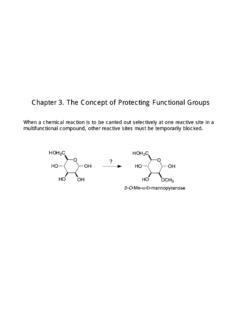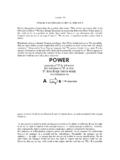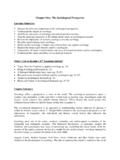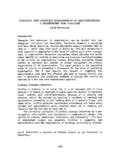Transcription of The Nervous 7 CHAPTER OUTLINE System W - UCY
1 CHAPTER OUTLINEWhat part of your brain is involved inlanguage? in memory? in emotions?Neuroscientists used to answer thesequestions by looking at specific types of brain damage and relating them to specificneurological problems. Now, highlysophisticated machines are peeking insideliving human brains and showing anastonishing level of detail about learning,emotions, and memory. Chief among theseharmless techniques is functional magneticresonance imaging, or fMRI. Regular MRIshows the location of soft tissue; fMRI tracksthe movement of glucose through the glucose is the basic fuel for the brain,fMRI shows which areas are active at any from just the past couple of yearsshow how much fMRI can reveal about brainfunction: Before surgery to correct epilepsy, fMRI canlocate speech centers, which are often dam-aged by this surgery. By identifying where inthe brain the patient forms words, surgeonscan avoid damaging the ability to speak. Brain images show differences between thebrains of dyslexic children and normalreaders.
2 Images made after intensive lan-guage treatment show how the brainchanges as the children gain languageproficiency. Men and women use their brains differ-ently, according to fMRI studies from theUniversity of Alberta. Sometimes malesand females would perform the sametasks and show different brain activation,and sometimes they would perform dif-ferent tasks and show the same brain acti-vation, said PhD student Emily Bell. Scientists at the University of Wisconsinshowed that brain regions associatedwith asthma can be activated when pa-tients hear the word wheeze. The studycould lead to new drugs and/or a better ap-preciation of the brain s role in Nervous System7 The Nervous System Makes Senseof Everythingp. 000 The Nervous System Is Categorized by Function and Structurep. 000 Nerve Tissue Is Made of Neurons and Glial Cellsp. 000 Neurons Work through ActionPotentialsp. 000 The Brain and Spinal Cord are Centralto the Nervous Systemp. 000 The Peripheral Nervous SystemOperates Beyond the Central NervousSystemp.
3 000 FFFFPPPPOOOO lllloooowwww 18-01-2007 16:34 Page 186 The Nervous System Makes Sense of Everything 189188 CHAPTER 7 The Nervous SystemThe Nervous System MakesSense of EverythingAXONAxon hillockMitochondrionCytoplasmDENDRITESN ucleusRough endoplasmicreticulumNucleus of Schwann cellSchwann cell: Node of RanvierAxon terminalSynaptic end bulbCytoplasmMyelin sheathPlasma membraneCELL BODYAxon collateralift this book. Turn the page. Scan thewords with your eyes and understandthem with your brain. All of these con-scious movements are directed by thenervous System . Brush a bothersome hair off your to tires crunch the pavement as a car drives pastthe open window. Smell the flowers outside. All of thesesensations are brought to you compliments of the ner-vous System . Every conscious action that occurs in yourbody is governed by the Nervous System . So are most ofthe unconscious or automatic actions that skeletal muscles contract, they do so inresponse to stimuli from the Nervous System .
4 We planour movement in the brain, and the Nervous systemtransmits that plan to the muscles. At the muscles, thenervous System stimulates contraction but stimulatesonly those motor units needed for that particular CHAPTER 6 you learned about neuromuscular junc-tions. Review Figure a quick reminder of this type of Nervous System activity isfamiliar, the Nervous System has numerous other func-tions, some better understood than others. The ner-vous System is used to communicate from one end ofthe body to another. The Nervous System receives andintegrates stimuli, and formulates an appropriate re-sponse. The stimulus can be an external change, suchas a shift in temperature or sound, or it can be an inter-nal change, such as a localized decrease in blood pres-sure or generally increased carbon dioxide levels in thetissues. Whatever the change, the Nervous System s jobis to immediately detect it and adapt in order to main-tain that change will involve the endocrinesystem, which produces hormones that work in concertwith the Nervous System .
5 The Nervous System usuallyinitiates immediate short-termresponses, using neurons(Figure ) and neuro-transmittersto produceamazingly fast results. In con-trast, the endocrine System re-lies on slower chemical inter-actions of hormones andtarget cells, which take longerto initiate a response thanneural responses but tend tolast longer. Your developmentfrom infancy to adulthood isdriven by hormones, whereas your startled jump at thesound of a car s backfire is caused by the neuron is the functional unit of the Nervous System . Theseremarkable cells are responsible for carrying sensoryinformation into the brain, formulating a response, and sendingthat response out to the proper nerve cell thatsends and receiveselectrical chemical used to transmit a Nervous impulse from one cell to the functions of the Nervous main difference between the endocrine System andthe Nervous CHECKL istfour of the manydifferent types of stimulithat the Nervous systemreacts to on a daily morequickly, the endocrinesystem or the nervoussystem?
6 Why? 18-01-2007 16:34 Page 188 The Nervous System is Categorized by Function and Structure 191190 CHAPTER 7 The Nervous SystemThe Nervous System is Categorized by Function and StructureThe PNS is composed of all the afferent andefferent neurons that extend from the CNS. The neu-rons of the PNS are arranged in bundles callednerves(Figure ). Nerves can be motor, sen-sory, or mixed, depending on what type of neuronsthey information go-ing to and from the centralnervous System travelsthrough the peripheral ner-vous System . Informationreaches the CNS from the af-ferentdivision of the periph-eral Nervous System . The PNSpicks up this information withone of three types of recep-tors: special senses, generalsensory receptors, or visceralreceptors. These receptors al-low us to experience many dif-ferent sensations. Our special sensesenable us to see,hear, taste, and smell the external world. Our skin hasgeneral sensory receptorsthat inform us about exter-nal temperature as well as light touch, pressure, andpain.
7 Within our bodies, visceral receptors monitorproprioceptionand organ functioning. Stomachachesand sore throats are examples of visceral sensory responses are formulated in the CNSand taken to the muscles or glands by the efferentdivi-sion of the PNS. Here again, the impulses can travel ondifferent pathways. To consciously move skeletal mus-cle, we plan an activity in the CNS and then direct themuscles to carry it out through motor commands sentby the somatic divisionof thePNS. This division is some-times called the voluntary divi-sion, because the motor com-mands are consciously, andtherefore voluntarily, con-trolled. However, the involun-tary movement of reflexes isalso part of this division. Thesame motor neurons that stim-ulate reflexive movements arethe ones we use when makinga conscious skinEntericplexusesin smallintestinePNS:CNS:PNS:PNS:Divisions of the Nervous systemFigure two main subdivisions of the Nervous System are the central Nervous System (CNS) consisting of the brain and spinal cord, and the peripheral Nervous System (PNS) consisting of and is covered by the CNS is the mainintegration center of the body.
8 Sensory informationcomes into the CNS, where it is analyzed and an appro-priate motor response is generated. The motor re-sponse is usually directed toward muscular or glandu-lar PERINEURIUMENDONEURIUMA xonsFascicle900xTransverse section of 12 nerve fasciclesSEMT ransverse section showing the coverings of a spinal nerveBlood vesselsENDONEURIUM aroundeach axonSpinal nerveEPINEURIUM aroundentire nerveFascicleAxonPERINEURIUM around eachfascicleABTransverse planeSpinal Nerve Figure are bundles of individual neurons, held together withconnective tissue wrappings. Outside of the nerve is theepineurium, protecting the nerve. Within the nerve, theperinuerium sheathes groups of neurons, whereas individualneurons are covered with an impulsesmoving toward the major divisions of the Nervous three types of receptors in the afferent Nervous differences between the somatic and autonomicdivisions of the efferent peripheral Nervous Nervous System has two components:the central Nervous System (CNS) andthe peripheral Nervous System (PNS)(Figure ).
9 The distinction isbased mainly on location. The CNS includes the brainand spinal cord. It lies encased in the axial skeletonTall Nervous tissue outside the CNS. Subdivisions of theperipheral Nervous System are the somatic Nervous System , theautonomic Nervous System , and the enteric Nervous functions of the sympathetic and parasympatheticdivisions of the autonomic Nervous from withinthe body giving information onbody position impulsesmoving from thebrain to the divisionDivision of the ner-vous System in-volved in 18-01-2007 16:34 Page 190 Nerve Tissue is Made of Neurons and Glial Cells 193192 CHAPTER 7 The Nervous SystemTHE AUTONOMIC Nervous SYSTEMWORKS WHILE YOU SLEEPThe autonomic divisionofthe PNS is a control systemthat governs your body s re-sponses to subtle changes inhomeostasis with involuntary,unconscious reactions. For ex-ample, the CNS continuallygenerates responses to sensoryinput concerning blood pres-sure, blood gases, and visceralfunctioning.
10 You are not aware of these inputs, nor doyou control the motor responses that travel throughthe autonomic Nervous autonomic Nervous System has two subdivi-sions. The first division, the sympathetic division,in-cludes those nerves that control the body when it is ac-tively moving, burning energy. The sympathetic divisionis sometimes called the fight or flight division, be-cause it is triggered when we feel threatened and mustchoose to remove ourselves from the danger (flight) orstay and fight. The parasympathetic divisionis respon-sible for digestion, energy storage, and relaxation(Table ).These divisions are nicely separated by the con-tradictory demands of human life. Sometimes we mustconserve energy and rest; other times we must movequickly and expend energy. When competing in an ath-letic event, or running from an alligator, we must useOutline of the Nervous System , including comparison of the sympathetic and parasympathetic characteristicsTable CHECKL istthe differences between the CNS and the the functions of the somatic division of the PNS?









